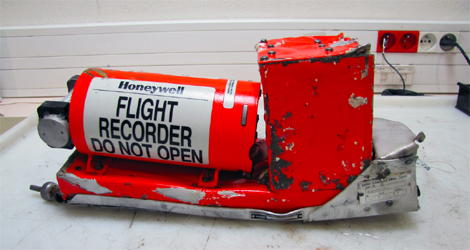The so called “Airplane black box” is the way Aviation industry has, since 1960s to ease the work of investigators in Aviation Accidents. Airplanes since then were all fitted with two independent “black boxes” (that are actually orange color) called DFDR (Digital Flight Data Recorders). These two independent recorders are the FDR (Flight Data Recorder) and CVR (Cockpit Voice Recorder).
Cost of each Black Box is up to USD 15.000 and, to be useful to investigation and post crash examination, the black boxes :
- must record as many parameters and voices as possible ;
- must resist to almost any kind of impact ;
- must be found after the any crash even underwater ;
The older models of Black Box were of course of magnetic tape technology but now they are all solid-state recorders without moving parts, thus more reliable. Nowadays data from both the CVR and FDR is stored on stacked memory boards inside the crash-survivable memory unit (CSMU). The memory boards have enough digital storage space to accommodate two hours of audio data for CVRs and 25 hours of flight data for FDRs.
FDR :
Airplanes are equipped with sensors that gather data such as acceleration, airspeed, altitude, flap settings, outside temperature, engine performance, and cabin temperature and pressure.
Whether the system is an older version or fully modern, all of the data collected by the airplane’s sensors is sent to the flight-data acquisition unit (FDAU). The flight-data acquisition unit is the middle manager of the entire data-recording process. It takes the information from the sensors and sends it on to the black boxes.
CVR :
In almost every commercial aircraft, there are several microphones built into the cockpit that listen to flight crew conversation. These microphones also track any ambient noise in the cockpit, such as switches being thrown or any knocks or thuds. There may be up to four microphones in the plane’s cockpit, each connected to the cockpit voice recorder (CVR).
Also Interphone communications are recorded (between Cockpit to ground staff or to the Cabin crew), PA (Public address messages, from any crew member to the passengers) and between cabin crew stations.
Most magnetic-tape CVRs store the last 30 minutes of sound. They use a continuous loop of tape that completes a cycle every 30 minutes. CVRs that use solid-state storage can record two hours of audio.
“Black boxes must survive almost any type of crash, fire, temperature and underwater environment.”
Every action in the cockpit or parameter from flight systems is recorded by the Black Box.
Few of the parameters recorder by most FDR are :
- Time
- Pressure altitude
- Airspeed
- Vertical acceleration
- Magnetic heading
- Control-column position
- Rudder-pedal position
- Control-wheel position
- Horizontal stabilizer
- Fuel flow
The data recorded must available in any situation, from a runway excursion to a crash into the ocean.
This is why DFDR are “Crash Survivable Memory Units” (CSMU) and they can survive almost any type of crash, fire, temperature, underwater environment. And this is why they are always fitted in the rear part of the airplane, that is supposed to be the last to crash. They must be resistant up to 3400 Gs, 2000 degrees fahrenheit (1100 celsius), submerged into salted water for 30 days and so on.
In addition to this , DFDR are equipped with an underwater locator beacon that sends out an ultrasonic pulse that is readily detectable by sonar and acoustical locating equipment. When water touches this sensor, the beacon is activated.
The beacon sends out pulses at 37.5 kilohertz (kHz) and can transmit sound as deep as 14,000 feet (4,267 meters). Once the beacon of the Black Box begins pinging, it pings once per second for 30 days.
After finding the black box, investigators take the recorders to a lab where they can download the data from the recorders and attempt to recreate the events of the accident. This process can take weeks or months to complete. In the United States, black box manufacturers supply the National Transportation Safety Board with the readout systems and software needed to do a full analysis of the recorders’ stored data.
If the FDR is not damaged, investigators can simply play it back on the recorder by connecting it to a readout system. With solid-state recorders, investigators can extract stored data in a matter of minutes through USB or Ethernet ports. Very often, recorders retrieved from wreckage are dented or burned. In these cases, the memory boards are removed, cleaned up and have a new memory interface cable installed. Then the memory board is connected to a working recorder. This recorder has special software to facilitate the retrieval of data without the possibility of overwriting any of it.
There are some improvements on the way for next generation black box :
- DFDR that self eject from the airplane ;
- recording of Video in the cockpit, although there’s a strong resistance by pilots and unions ;
- data that are real-time sent to satellite (to cope with events like disappeared Malaysia B777).
The key focus of next generation Black Box , after the Malaysia B777 crash (it’s end of 2015 and Airplane and Black Boxes ye have not been found) is the “live streaming” of the data. Recordings should not be stored into a Black Box but instead uploaded real time through satellite network. GPS satellite network is available at any latitude in any part of the planet. Of course it’s a matter of costs for the Companies and everything is under evaluation. You can read out more here.

